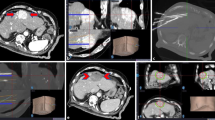Abstract
Local tumor ablation either by high or low temperatures is an ever increasing local therapeutic procedure in the interdisciplinary armamentarium of anticancer therapy. As cryoablation (local cancer tissue destruction by low temperature) is technically demanding, rather expansive and thus has gained low acceptance and low distribution in interventional oncologic radiology, this paper will focus on the state-of-the-art of local tumor cell destruction by high temperatures and electroporation: radiofrequency ablation (RFA), microwave ablation (MWA), and irreversible electroporation (IRE).


Similar content being viewed by others
References
Crocetti L, de Baere T, Lencioni R. Quality improvement guidelines for radiofrequency ablation of liver tumors. Cardiovasc Intervent Radiol. 2010;33:11–7. doi:10.1007/s00270-009-9736-y.(CIRSE Guidelines)
Bruix J, Sherman M, Llovet JM, et al.; EASL panel of experts on HCC. Clinical management of study of the liver. J Hepatol. 2001;35:421–30.
Bruix J, Sherman M. Management of hepatocellular carcinoma. Hepatology. 2005;42:1208–36.
Lencioni R, Allgaier HP, Cioni D, et al. Small hepatocellular carcinoma in cirrhosis: randomized comparison of radiofrequency thermal ablation versus percutaneous ethanol injection. Radiology. 2003;228(1):235–40
Llovet JM, Vilana R, Bru C, et al.; Barcelona Clinic Liver Cancer (BCLC) Group. Increased risk of tumor seeding after percutaneous radiofrequency ablation for single hepatocellular carcinoma. Hepatology. 2001;33:1124–9.
Ruers T, et al. Radiofrequency ablation combined with systemic treatment versus systemic treatment alone in patients with non-resectable colorectal liver metastases: a randomized EORTC Intergroup phase II study (EORTC 40004). Ann Oncol. 2012;23(10):2619–26.
Ruers T, et al. Radiofrequency ablation (RFA) combined with chemotherapy for unresectable colorectal liver metastases (CRC LM): long-term survival results of a randomized phase II study of the EORTC-NCRI CCSG- ALM Intergroup 40004 (CLOCC). J Clin Oncol. 2015; 33. (suppl; abstr 3501; oral presentation)
Dietrich CF, Cui XW, Chiorean L, Appelbaum L, Leen E, Ignee A. Local ablative procedures of the liver. Z Gastroenterol. 2015;53(06):579–90. doi:10.1055/s-0034-1399446.
Chen MS, Li JQ, Zheng Y, Guo RP, Liang HH, et al. A prospective randomized trial comparing percutaneous local ablative therapy and partial hepatectomy for small hepatocellular carcinoma. Ann Surg. 2006;243(3):321–8.
Lu MD, Kuang M, Liang LJ, Xie XY, Peng BG, et al. Surgical resection versus percutaneous thermal ablation for early-stage hepatocellular carcinoma: a randomized clinical trial. Zhonghua Yi Xue Za Zhi. 2006;86(12):801–5.
Mulier S, Ni Y, Jamart J, Ruers T, Marchal G, et al. Local recurrence after hepatic radiofrequency coagulation: multivariate meta-analysis and review of contributing factors. Ann Surg. 2005;242(2):158–71.
Silen W. Hepatic resection for metastases from colorectal carcinoma is of dubious value. Arch Surg. 1989;124(9):1021–2.
Livraghi T, Solbiati L, Meloni F, Ierace T, Goldberg SN, et al. Percutaneous radiofrequency ablation of liver metastases in potential candidates for resection. The “Test-of-Time” approach. Cancer. 2003;97(12):3027–35.
Scorsetti M, Clerici E, Comito T. Stereotactic body radiation therapy for liver metastases J Gastrointest Oncol. 2014;5(3):190–7. doi:10.3978/j.issn.2078–6891.2014.039.
Abi-Jaoudeh N, Kruecker J, Kadoury S, et al. Multimodality image fusion-guided procedures: technique, accuracy and applications. Cardiovasc Intervent Radiol. 2012;35:986–98.
Wood BJ, Kruecker J, Abi-Jaoudeh N, et al. Navigation systems for ablation. J Vasc Interv Radiol. 2010;21:257–63.
Wallach D, Toporek G, Weber S, Bale R, Widmann G. Comparison of freehand-navigated and aiming device-navigated targeting of liver lesions. Int J Med Robot. 2014;10(1):35–43.
Peng ZW, Zhang YJ, Chen MS, et al. Radiofrequency ablation with or without transcatheter arterial chemoembolization in the treatment of hepatocellular carcinoma: a prospective randomized trial. J Clin Oncol. 2013;31:426–32.
Strickland AD, Clegg PJ, Cronin NJ, et al. Experimental study of large-volume microwave ablation in the liver. Br J Surg. 2002;89(8):1003–7.
Yang D, Converse MC, Mahvi DM, Webster JG. Measurement and analysis of tissue temperature during microwave liver ablation. IEEE Trans Biomed Eng. 2007;54(1):150–5.
Wang Y, Sun Y, Feng L, Gao Y, Ni X, Liang P. Internally cooled antenna for microwave ablation: results in ex vivo and in vivo porcine livers. Eur J Radiol. 2008;67(2):357–61.
Van Sonnenberg E, McMullen W, Solbiati L. Tumor ablation. Principles and practice. New York: Springer; 2005.
Davalos R, Mir LM, Rubinsky B. Tissue ablation with irreversible electroporation. Ann Biomed Eng. 2005;33(2):223–31.
Maor E, Ivorra A, Leor J, Rubinsky B. The effect of irreversible electroporation on blood vessels. Technol Cancer Res Treat. 2007;6(307):307–12.
Narayanan G, Bhatia S, Echenique A, Suthar R, Barbery K, Yrizarry J. Vessel patency post irreversible electroporation. Cardiovasc Intervent Radiol. 2014;37(6):1523–9.
Weng M, Zhang Y, Zhou D, Yang Y, Tang Z, Zhao M, Quan Z, Gong W. Radiofrequency ablation versus resection for colorectal cancer liver metastases: a meta-analysis. PLoS One. 2012;7(9):e45493. doi:10.1371/journal.pone.0045493.
Lencioni R, Crocetti L, Cioni D et al (2004) Percutaneous radiofrequency ablation of hepatic colorectal metastases. Technique, indications, results, and new promises. Invest Radiol 39:689–697
Gillams AR, Lees WR (2004) Radio-frequency ablation of colorectal liver metastases in 167 patients. Eur Radiol 14:2261–2267
Machi J, Oishi AJ, Sumida K et al (2006) Long-term outcome of radiofrequency ablation for unresectable liver metastases from colorectal cancer: evaluation of prognostic factors and effectiveness in first- and second-line management. Cancer J 12:318–326
Sorensen SM, Mortensen FV, Nielsen DT (2007) Radiofrequency ablation of colorectal liver metastases: long-term survival. Acta Radiol 48:253–258
Veltri A, Sacchetto P, Tosetti I, Pagano E, Fava C, Gandini G (2008) Radiofrequency ablation of colorectal liver metastases: small size favorably predicts technique effectiveness and survival. Cardiovasc Intervent Radiol 31:948–956
Author information
Authors and Affiliations
Corresponding author
Rights and permissions
About this article
Cite this article
Schuster, H., Kopf, H. Thermoablation: a new treatment option to replace surgical intervention?. memo 8, 242–246 (2015). https://doi.org/10.1007/s12254-015-0232-6
Received:
Accepted:
Published:
Issue Date:
DOI: https://doi.org/10.1007/s12254-015-0232-6




